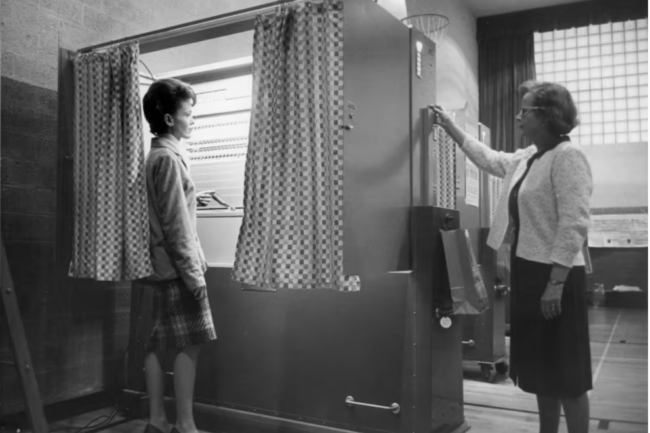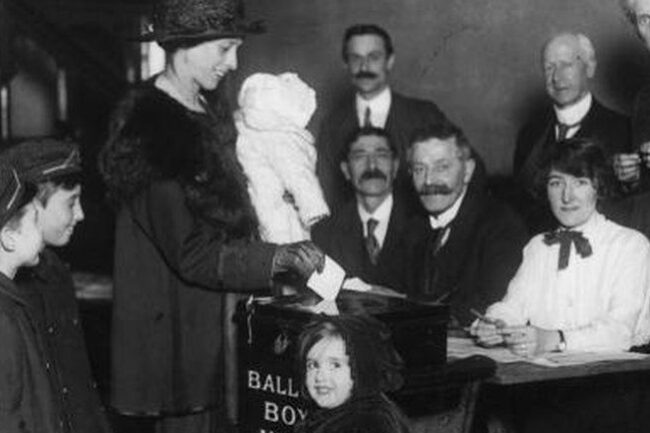When it comes to addressing large-scale structural problems that affect us as a society—whether it is climate change or local community building—we tend to disregard the individual’s power to make things change.
Our capacity for demanding action is best represented by voting. This participatory tool allows us to have a say on what we want to happen or who we want to govern us.
Voting has been an integral part of civilization since humans began assembling and making communal decisions—whether it was choosing what cave to settle in or what territory to conquer next. As we became more organized and society solidified, voting became a crucial pillar of democracy, giving people the authority to choose their government and legislation. It’s a tool that grants people the right (and duty) to decide who will lead them for a definite amount of time at a local and national level, based on the majority’s will. But it wasn’t always the case. Suffrage—which in one Latin definition means influence—was the result of Greek philosophers and Roman politicians who agreed that tyrant rulers weren’t always thinking in the masses’ best interest.
Despite encountering many hiccups and requiring adjustments along the way (women first voted in national elections in 1893, when New Zealand became the first country to grant them that right , and African Americans couldn’t cast a ballot until Martin Luther King and the civil rights movement of the 1960s challenged the racist status quo), voting appears to be the best way for citizens to participate in politics.
Throughout history, different voting methods have been used (with diverse outcomes), allowing individuals to proclaim their allegiance to a particular ideology or proposal. From a simple show of hands to parliamentary vociferation (viva voce), to the use of marbles placed in a drum (The Gambia applied this method to facilitate the act to the country’s illiterate population), we’ve found a way to represent the multitude’s demands.
Despite its usefulness, voting doesn’t always go well. The main hurdle when it comes to voting is the possibility of encountering fraud in the way of lost ballots, miscounts, or rigging—an issue that has raised a concern with the vote-by-mail version that will determine a victor in the run for The White House. Although casting a ballot via the USPS has proven to be successful (the U.S. Army has used this method since the Civil War), there’s a concern with the Trump-Biden showdown outcome, considering the foreign interference that happened in the 2016 elections.
Could machines have been a better solution?

In 2005, Estonia became the first country to implement the i-vote (still executed), saving the nation a cumulative time of 11,000 working hours. The government has created a system whereby users can log their choice during a pre-voting period—and change their mind as many times as they want—before anonymously registering their vote during election day. A similar approach has been explored by Miami-based tech company ONR, which focuses on providing online community engagement mechanisms for condos and homeowners associations.
“We saw an opportunity to streamline an association’s services and voting requirements by bringing matters into the 21st century, allowing residents to book amenities and participate in assemblies through our app, regardless of where they were”, says Carlos Guzmán, one of the co-founders. ONR currently has contracts with 155 buildings, serving almost 52,000 active users. “We estimate that we’ve saved the associations upwards of $3.4M in logistical costs—but the best part of all? We’re giving owners a voice while allowing associations to make data-driven decisions.”
Would digitalizing voting make it easier and be the answer to increase electoral participation?
In the case of ONR, it has worked: “on average, the condominiums we work with used to see only 15-20% of the residents casting their ballots, but since implementing our app’s solutions, we’ve seen those numbers increase between 60-80%”, says Guzmán, who highlights the fact that urbanization will continue to grow, requiring more people to vote in associations.
“After the Great Depression, the world slowly began its economic recovery, and with it, people wanted to live in the suburbs, which in turn meant the communities had to devise new sets of rules, but everyone still lived in their own patches of land—there was still a sense of disconnection when it came to decision-making,” he says. “Fast forward to the 1970s, and we see 10% of the US population move to 17,000 urban communities; nowadays, there are almost 350,000 associations in the country, with the number expected to rise to 500,000 by 2040.”
Besides solving organization and logistical hurdles, ONR’s main objective is to provide a platform that solves community disengagement, allowing homeowners to connect with individuals who share the same space where they’ve invested their money and energy, the place we call home. “This isn’t technology for the sake of technology; we want people to come together. ONR does it through streamlining processes and driving participation, which ultimately results in more people being more invested in the outcome of the condo’s offerings”.
Sure, as apartment owners, we want to have a say in the swimming pool’s remodeling, the gym schedule, or the valet parking solutions. We must have control of our living experience, but ONR’s goal is to foster an environment where we connect to those around us, solidifying interactions. “We believe in the power of building bridges between neighbors; it’s the first step in changing the way we think, improving our quality of life, and establishing deep-rooted relationships,” adds Guzmán. “The whole point of digital transforming our lives is to improve them, not alienate ourselves. We’re in this business to facilitate voting, develop stronger connections, and build thriving communities”.
—[/vc_column_text][/vc_column][/vc_row]



